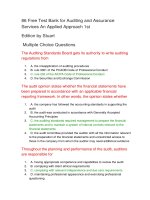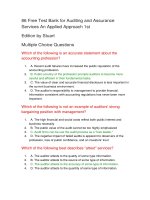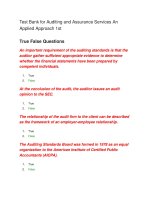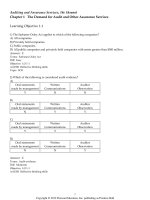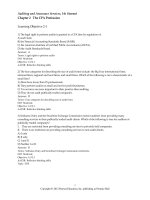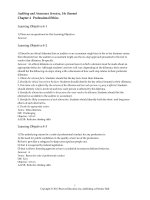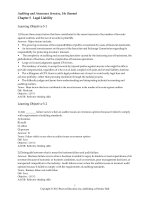Solution manual for auditing and assurance services a systematic approach 7th edition by messier
Bạn đang xem bản rút gọn của tài liệu. Xem và tải ngay bản đầy đủ của tài liệu tại đây (65.76 KB, 6 trang )
Full file at />
CHAPTER 1
AN INTRODUCTION TO ASSURANCE AND FINANCIAL
STATEMENT AUDITING
Answers to Review Questions
1-1
The study of auditing is more conceptual in nature compared to other accounting courses.
Rather than focusing on learning the rules, techniques, and computations required to
prepare financial statements, auditing emphasizes learning a framework of analytical and
logical skills to evaluate the relevance and reliability of the systems and processes
responsible for financial information, as well as the information itself. To be successful,
students must learn the framework and then learn to use logic and common sense in
applying auditing concepts to various circumstances and situations.
Understanding auditing can improve the decision making ability of consultants, business
managers, and accountants by providing a framework for evaluating the usefulness and
reliability of information—an important task in many different contexts.
1-2
There is a demand for auditing in a free-market economy because the agency relationship
between an absentee owner and a manager produces a natural conflict of interest due to
the information asymmetry that exists between the owner and manager. As a result, the
agent agrees to be monitored as part of his/her employment contract. Auditing appears to
be a cost-effective form of monitoring.
The empirical evidence suggests auditing was demanded prior to government regulation.
In 1926, before it was required by law, independent auditors audited 82 percent of the
companies on the New York Stock Exchange. Additionally, many private companies and
municipalities not subject to government regulations such as the Securities Act of 1933
and Securities Exchange Act of 1934 also purchase various forms of auditing and
assurance services.
1-3
The agency relationship between an owner and manager produces a natural conflict of
interest because of differences in the two parties’ goals and because of the information
asymmetry that exists between them. That is, the manager may well have different goals
than the owner, and generally has more information about the "true" financial position and
results of operations of the entity than the absentee owner does. If both parties seek to
maximize their own self-interest, it is likely that the manager will not act in the best
interest of the owner and may manipulate the information provided to the owner
accordingly.
1-4
Independence is a bedrock principle for auditors. If an auditor is not independent of the
client, users may lose confidence in the auditor’s ability to report objectively and
truthfully on the financial statements, and the auditor’s work loses its value. From an
agency perspective, if the principal (owner) knows that the auditor is not independent, the
owner will not trust the auditor’s work. Thus, the agent will not hire the auditor because
the auditor’s report will not be effective in reducing information risk from the perspective
of the owner.
buy this full document at
Full file at />
1-5
Auditing (broadly defined) is a systematic process of (1) objectively obtaining and
evaluating evidence regarding assertions about economic actions and events to ascertain
the degree of correspondence between those assertions and established criteria and
(2) communicating the results to interested users.
Attest services occur when a practitioner issues a report on subject matter, or an assertion
about subject matter, that is the responsibility of another party.
Assurance services are independent professional services that improve the quality of
information, or its context, for decision makers.
1-6
The phrase systematic process implies that there should be a well-planned, logical
approach for conducting an audit that involves objectively obtaining and evaluating
evidence.
1-7
Materiality is defined as "the magnitude of an omission or misstatement of accounting
information that, in the light of surrounding circumstances, makes it probable that the
judgment of a reasonable person relying on the information would have been changed or
influenced by the omission or misstatement" (AU 312). Audit risk is defined as the risk
that the auditor may unknowingly fail to appropriately modify his or her opinion on
financial statements that are materially misstated (AU 312).
The concept of materiality is reflected in the wording of the auditor's standard audit report
through the phrase "the financial statements present fairly in all material respects." This
is the manner in which the auditor communicates the notion of materiality to the users of
the auditor's report. The auditor's standard report states that the audit provides only
reasonable assurance that the financial statements do not contain material misstatements.
The term "reasonable assurance" implies that there is some risk that a material
misstatement could be present in the financial statements and the auditor will fail to detect
it.
1-8
On most audits, it is not feasible or cost-effective to audit all transactions. For example, in
a small business, the auditor might be able to examine all transactions that occurred during
the period. However, it is unlikely that the owner of the business could afford to pay for
such an extensive audit. For a large organization, the sheer volume of transactions
prevents the auditor from examining every transaction. Thus, there is a trade-off between
the exactness or precision of the audit and its cost.
1-9
The major phases of the audit are:
• Client acceptance/continuance and establishing an understanding with the client
• Preliminary engagement activities
• Plan the audit
• Consider and audit internal control
• Audit business processes and related accounts
• Complete the audit
• Evaluate results and issue audit report
buy this full document at
Full file at />
1-10 The auditor’s understanding of the entity and its environment includes knowledge about:
(1) the client’s industry, regulatory, and other external factors, (2) the nature of the entity,
(3) its objectives and strategies, (4) its measurement and performance review process, and
(5) the entity’s system of internal control.
1-11 The four paragraphs of the auditor's standard unqualified report for a public company
client are: (1) the introductory paragraph, (2) the scope paragraph, (3) the opinion
paragraph, and (4) an explanatory paragraph referring to the audit of internal control, as
illustrated in this chapter.
1-12 Auditors frequently face situations where no standard audit procedure exists, such as the
example from the text of verifying the inventory of cattle. Such circumstances require that
the auditor exercise creativity and innovation when planning and administering audit
procedures where little or no guidance or precedent exists. Every client is different, and
applying auditing concepts in different situations requires logic and common sense, and
frequently creativity and innovation.
Answers to Multiple-Choice Questions
1-13
1-14
1-15
1-16
1-17
1-18
B
B
C
C
C
C
1-19
1-20
1-21
1-22
1-23
A
D
D
D
B
Solutions to Problems
1-24 The memo should cite the following facts:
• There is a historical relationship between accounting and auditing.
• When parties to the agency relationship (contract) do not possess the same amount of
information (information asymmetry) there is a natural conflict of interest between the
parties. For example, when an owner and manager are negotiating an employment
contract, the owner may assume that the manager likely will use organizational funds
for personal uses. Auditing plays an important role in such relationships. The owner
and manager will consummate an employment contract only if the manager agrees to
be monitored. Auditing can be used to monitor the contract agreed to by the two
parties. (P.S. As an attorney, Lee should be well versed on contract law.)
• Auditing is also used to monitor other types of contracts for which no laws or
regulations require an audit, for example, contracts between management and debt
holders.
• There is historical evidence of forms of auditing in the early Greek states and in the
United Kingdom during the industrial revolution. More relevant evidence is the fact
that 82 percent of the NYSE companies were audited prior to the securities acts.
buy this full document at
Full file at />
•
Additional evidence for the demand for auditing is also provided by the fact that many
private companies and municipalities not subject to the securities acts contract for
audits.
1-25 There are two major factors that may make an audit necessary for Greenbloom Garden
Centers. First, the company may require long-term financing for its expansion into other
cities in Florida. Entities such as banks or insurance companies are likely to be the
sources of the company's debt financing. These entities normally require audited financial
statements before lending significant funds and generally require audited financial
statements during the time period the debt is outstanding. There is information asymmetry
between the lender of funds and the owner of the business, and this asymmetry results in
information risk to the lender. Even if the business could get funding without an audit, a
clean audit report by a reputable auditor might very well reduce the lender’s information
risk and make the terms of the loan more favorable to the owner. Second, as the company
grows, the family will lose control over the day-to-day operations of the stores. An audit
can provide an additional monitoring activity for the family in controlling the expanded
operations of the company.
1-26
a. Evidence that assists the auditor in evaluating financial statement assertions consists
of the underlying accounting data and any additional information available to the
auditor, whether originating from the client or externally.
b. Management makes assertions about components of the financial statements. For
example, an entity's financial statements may contain a line item that accounts
receivable amount to $1,750,000. In this instance, management is asserting, among
other things, that the receivables exist, the entity owns the receivables, and the
receivables are properly valued. Audit evidence helps the auditor determine whether
management’s assertions are being met. If the auditor is comfortable that he or she
can provide reasonable assurance that all assertions are met for all accounts, he or she
can issue a clean audit report. In short, the assertions are a conceptual tool to help the
auditor ensure that she or he has “covered all the bases.”
c. In searching for and evaluating evidence, the auditor should be concerned with the
relevance and reliability of evidence. If the auditor mistakenly relies on evidence that
does not relate to the assertion being tested, an incorrect conclusion may be reached
about the management assertion. Reliability refers to the ability of evidence to signal
the true state of the assertion, i.e. whether it is actually being met or not.
1-27
a.
The major phases of the audit and their descriptions are:
1. Client acceptance/continuance and establish an understanding with the client. The
auditor decides to accept a new client or to retain an existing client. The auditor
establishes an understanding with the client regarding the services to be
performed, engagement timing, fees, etc.
2. Preliminary engagement activities. This phase involves determining the audit
engagement team requirements and ensuring the independence of the audit team
and audit firm, among other things.
3. Plan the audit. During this phase of the audit, the auditor uses the knowledge of
the client to plan the audit and perform preliminary analytical procedures. The
buy this full document at
Full file at />
4. purpose of this phase is to plan an effective and efficient audit.
4. Consider and audit internal control. The auditor understands and evaluates the
client’s internal controls in order to assess the risk that they will not prevent or
detect a material misstatement. In the case of a public company, the auditor will
conduct an audit of internal control over financial reporting.
5. Audit business processes and related accounts. The auditor conducts substantive
tests, including analytical procedures and the details of the account balances,
searching for material misstatements.
6. Complete the audit. The auditor searches for contingent liabilities and subsequent
events, and performs a final review of the evidence gathered.
7. Evaluate results and issue the audit report. Based on the collection and evaluation
of evidence, the auditor issues a report on whether the financial statements are
fairly presented.
b. While audit procedures may be designed to test a specific assertion, they often
simultaneously provide evidence on another account or assertion. An example would
be when an auditor obtains evidence about a client’s transactions affecting the
inventory account and whether shipments of inventory to customers were included in
the proper period. Such evidence may also be relevant to the client’s assertions
regarding whether accounts receivable balances were correct at the end of the period.
c. Auditors develop an understanding of an entity's internal control in order to establish
the scope of the audit. However, during the course of this work, the auditor may
become aware of weaknesses in the entity's accounting systems. The auditor is
required to communicate this information to management. The auditor may also
make suggestions on how to correct the weaknesses. The auditor's work on internal
control may also have a preventive effect on the behavior of the entity's employees.
If the employees know that their work will be audited, they are less likely to commit
errors or fraud. Because of the Sarbanes-Oxley Act, internal control is a topic that is
front-and-center in the accounting profession.
1.28A search of the homepage of most public companies will include links to their latest
financial information or 10-K filings. The SEC’s homepage will also include this
information along with any other recent filings. Examining the independent auditor’s report
and financial statements will allow the student have a better idea as to how the chapter’s
information is applied in real companies.
1.29Scope paragraph: “These standards require that we plan and perform the audit to obtain
reasonable assurance about whether the financial statements are free of material
misstatement.” The use of the term reasonable assurance indicates that there is no guarantee
that the financial statements are correct, only “reasonable assurance.” Also the statement
that the financials are “free of material misstatement” indicates that the financials may have
some error that is not material.
“An audit also includes assessing the accounting principles used and significant estimates
made…” The explanation that management uses estimates indicates that some of the
figures in the financial statements are not exact.
buy this full document at
Full file at />
“We believe that our audits provide a reasonable basis for our opinion.” This statement
indicates that the audit is not “proof” that the financial statements are exact, only that there
is reasonable evidence about their accuracy.
Opinion paragraph: “…the consolidated financial statements referred to above present
fairly, in all material respects,…” This sentence indicates that the financial statements are a
“fair”, not exact, representation. Also, the idea of materiality is revisited here, indicating
that there may still be relatively small errors in the financial statements.
Solutions to Discussion Cases
1-30 Independent audits are a critical component of corporate governance and can enhance the
effectiveness of the examination and supervision process. Such audits can improve the
reliability of financial reports and help identify internal control weaknesses. Thus, such
audits can benefit bank examiners in enhancing the safety and soundness of financial
institutions.
Solutions to Internet Assignments
1-31
There are numerous Internet sites that contain accounting information. Following are
some suggested sites:
• The AICPA's home page (www.aicpa.org) contains extensive information on the
organization's activities. For example, it contains the entire report of the Special
Committee on Assurance Services.
• The American Accounting Association’s home page (www.aaahq.org) contains
numerous links, including professional organizations, accounting journals, and
education sites.
• The Association of Certified Fraud Examiners (www.cfenet.com) home page contains
extensive information on the Association’s certification as Certified Fraud Examiners
(CFE).
• The Institute of Internal Auditors (www.theiia.org) home page contains detailed
information on internal auditing.
• The International Federation of Accountants (www.ifac.org) Web site provides
detailed information on international accounting and auditing standards.
• The Government Accountability Office (formerly the General Accounting Office,
www.gao.gov) Web site provides detailed information on the GAO’s activities and
allows users to obtain copies of GAO reports.
• The SEC’s Edgar Web site (www.sec.gov) contains all filings by public companies
with the SEC. It also contains information on other activities by the SEC.
• The PCAOB’s Web site (www.pcaob.org) offers detailed information about the
PCAOB and the standards it has proposed and established.
• The major public accounting firms and many smaller firms also maintain Web sites.
buy this full document at
